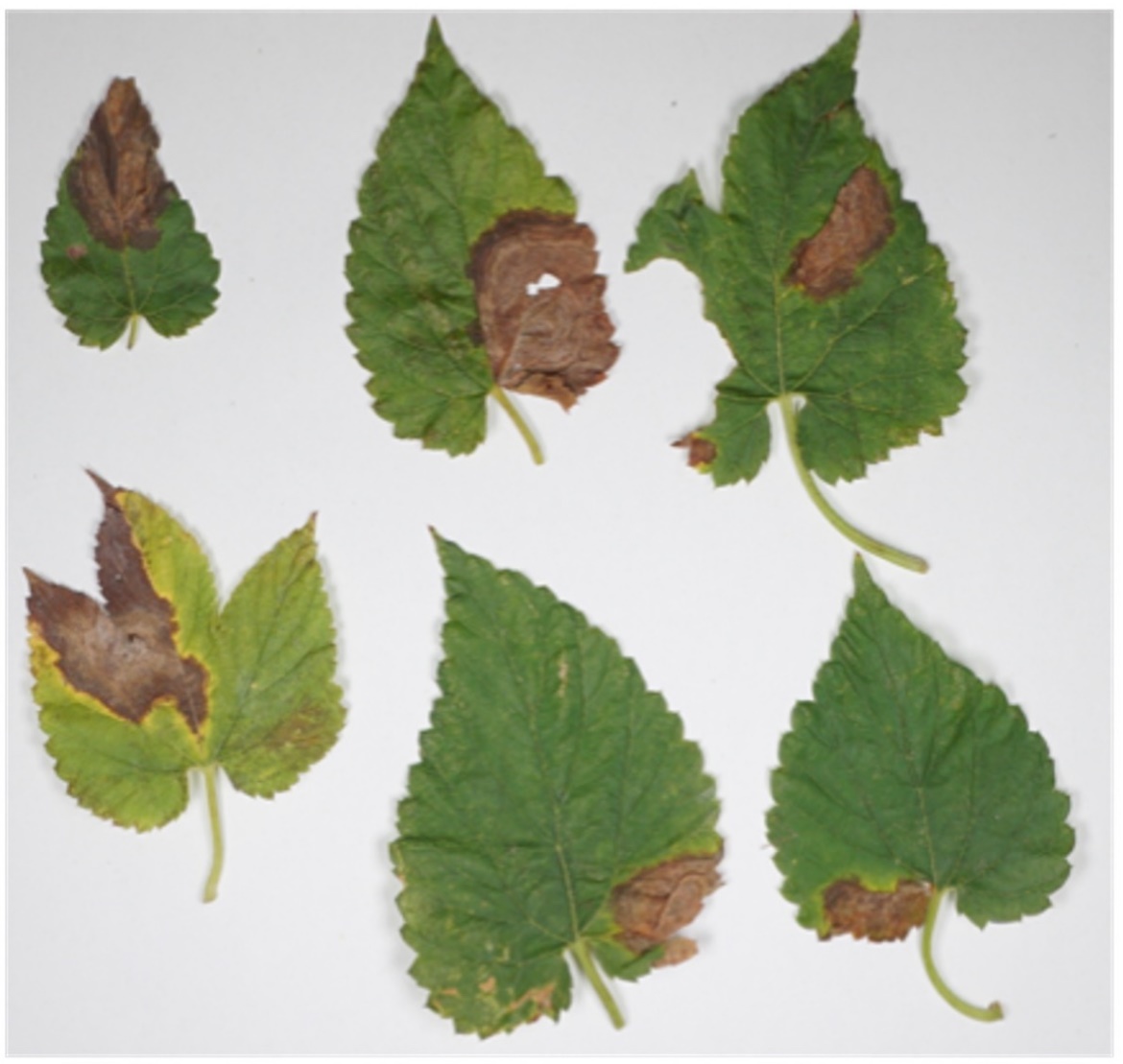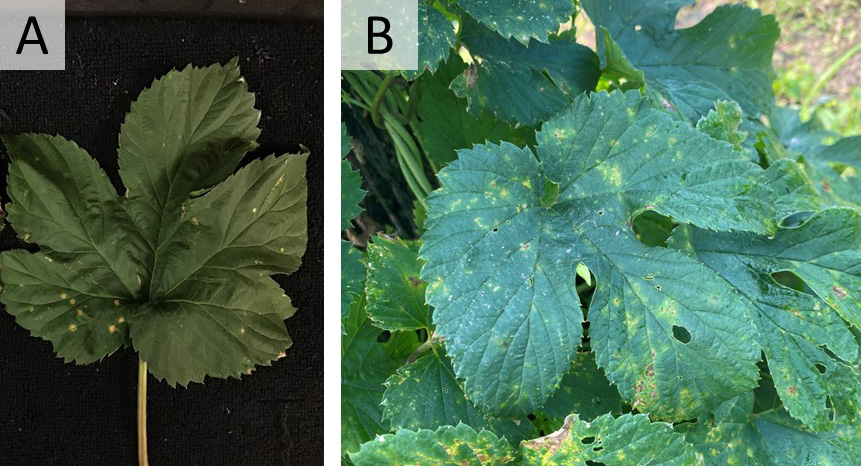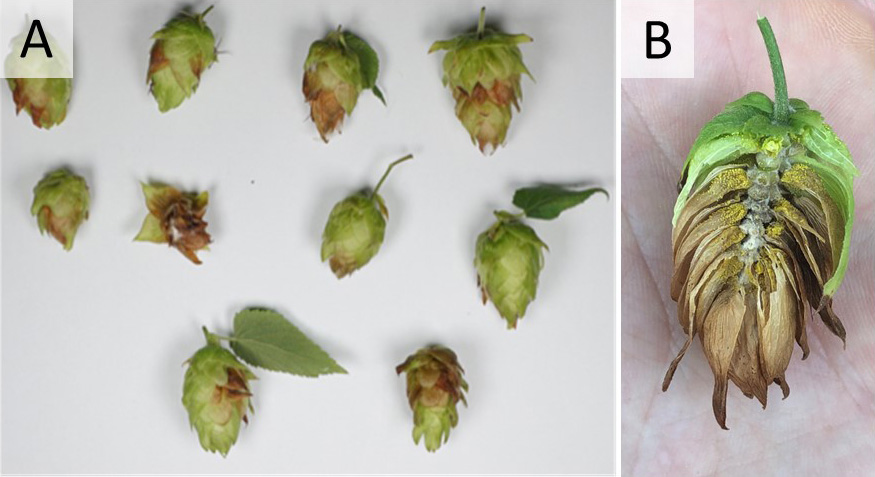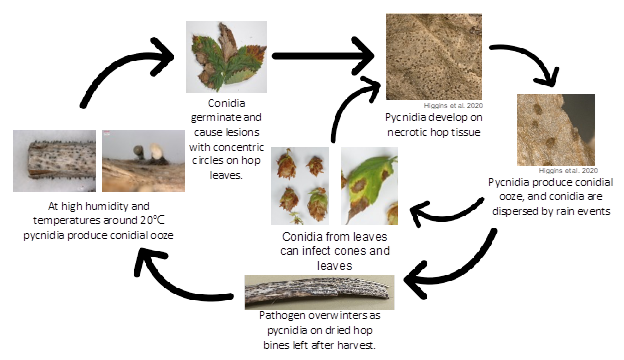
Managing Halo Blight of Hop
DOWNLOADFebruary 16, 2024 - Ross J. Hatlen, Erin Lizotte, Rob Sirrine and Timothy D. Miles
Halo blight of hop is caused by the fungus Diaporthe humulicola and is a major concern for hop growers in Michigan and in other parts of the Midwest. The pathogen was first discovered in 2018 but was not formally described until 2021. The disease has been reported in four different hop producing states in the northeastern United States. The pathogen can cause high amounts of yield loss and can change the chemical composition in the hop cone.
Symptoms
Halo blight of hop first appears in late spring to early summer as brown to gray lesions that develop on the hop leaves that are surrounded by a chlorotic (yellow to light green) halo (Figure 1). The lesions may have concentric rings radiating from the center of the leaf lesion, but rings may not be present (Figure 1).

Smaller lesions or lesions that are early in development may be mistaken as another fungus Colletotrichum fioriniae (Figure 2). Brown to black fungal, spore producing structures (pycnidia) may appear on the surface of the leaf lesion, resembling pimples. Hop leaves may have multiple lesions at different stages of development on a single leaf. The pathogen also seems to be able to colonize dead or discarded leaf tissue during the growing season.

The pathogen can also infect hop cones and burrs. Hop burrs become necrotic and desiccated. The cone’s bracts become desiccated, leaving bract tissue a light to dark brown color. The desiccation can occur on single bracts or whole sections of the hop cone (Figure 3A). Brown to black pycnidia can develop on the surface of the hop cone. Late in the season, white mycelia can be seen on the hop rachis (strig), but this is not a consistent stage of the disease development (Figure 3B). Infected hop cones with desiccated cone tissue often shatter upon harvest, resulting in yield losses up to 50%. Cones that survive harvest with moderate levels of halo blight seem to have an altered aroma profile; growers report that infected cones often have a “cheese like” aroma. It is important to note that other diseases can also cause cone desiccation such as downy mildew, powdery mildew, alternaria cone disorder and fusarium cone tip blight.

After harvest in the late fall to winter, D. humulicola can colonize the left-over bine tissue and produce pycnidia on the surface of the tissue (Figure 4).

Disease cycle
The pathogen overwinters on dried hop tissue as pycnidia (small black fungal structures). When conditions are warm (>60 degrees Fahrenheit, or 15.6 degrees Celsius) and humid, the pycnidia will sporulate and produce conidia. The conidia are released from the pycnidia and dispersed by weather events. The pathogen causes lesions on the surface of the hop leaf that give rise to new pycnidia. Pycnidia produce conidia that can infect the burrs/cones and leaves, causing lesions on the leaves and desiccation of the hop cone. This portion of the life cycle seems to be polycyclic and if environmental conditions are right, the hop plant can go through multiple infection cycles per year. In the late summer or early fall, the pathogen seems to colonize hop bines that have been left after harvest, where the pathogen remains dormant until late spring early summer (Figure 5).
Management
Cultural
In early fall, post-harvest dead material and new shoots should be removed to prevent colonization and overwintering by D. humulicola. Post-harvest hop plants can also have the top layer of their crown removed in a process called crown pruning, which can reduce inoculum of the pathogen that can infect the hop crown. Extensive research has been done on crown pruning for downy and powdery mildew control, and anecdotal evidence from hop growers in Michigan suggest it may offer some control of halo blight as well.
There appears to be a correlation between the severity of downy mildew symptoms and the severity of halo blight symptoms, therefore early season downy mildew disease management can be a preventive measure against halo blight of hops.
Chemical
The disease is present throughout the hop growing season, so multiple chemical applications for halo blight will likely be needed per season. At the time of this publication, no fungicides are registered for this disease, but there is evidence that fungicides registered for powdery mildew with the active ingredients trifloxystrobin (FRAC 11), flutriafol (FRAC 3), tebuconazole (FRAC 3) and fluopyram (FRAC 7) have been shown to cause a reduction in
the incidence and severity of halo blight symptoms. These products include the commercial fungicides Flint Extra (Bayer), Rhyme (FMC) and Luna Experience (Bayer). Biological fungicides like Lifegard (Bacillus mycoides Isolate J – Certis USA) have also been shown to reduce foliar symptoms of halo blight. Furthermore, we have noticed that controlling downy mildew with a chemical management strategy can reduce the incidence and severity of halo blight. Downy mildew is typically controlled with entirely different modes of action (FRAC classes 4, 11, 21, 27, 40, 43, 45 and 49).
It is important to manage fungicide resistance and avoid applying similar products back-to-back. This is particularly important with site-specific systemic fungicides. To reduce the development of resistance with systemic fungicides:
- Do not make more than three applications per season of the same FRAC code.
- Do not make two consecutive applications of the same FRAC code.
- Rotate with unrelated fungicides in a different FRAC code that have efficacy on the target pathogen.




 Print
Print Email
Email


